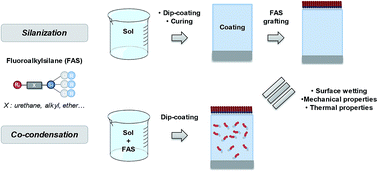Distribution of fluoroalkylsilanes in hydrophobic hybrid sol–gel coatings obtained by co-condensation†
Abstract
Whether it is for imparting anti-corrosion, anti-fogging or stable optical properties, hydrophobic coatings have been at the center of numerous research studies these last few decades. While surface perfluorination and surface roughening have been thoroughly studied, few studies discuss the introduction of fluoroalkylsilanes (FASs) directly into sol–gel networks in order to obtain water-repellent silica films. The latter method, referred to as co-condensation, is yet easier to perform (one-pot and mild conditions) and in accordance with industrial standards. However, so far its implementation to achieve maximum surface hydrophobicity has not been well-controlled and the influence of such FAS molecules trapped in the sol–gel network on the mechanical properties has not been investigated. In this work, how the co-condensation method affects the distribution of the fluorinated additives in the sol–gel network is studied by obtaining a precise XPS profile of the FASs within the material. The water-repellent, optical and mechanical properties of such coatings were evaluated. From these results, the one-step co-condensation method was proved to exhibit similar properties to a classic multi-step surface silanization. Moreover, by getting a better understanding of the mechanisms involved during the film formation, it is henceforth possible to accurately control the concentration of FASs needed to optimize the water-repellency. Besides, it was demonstrated that these results were not impacted by the chemical structure of the FASs, thus highlighting various alternative synthesis strategies of interest. Based on these conclusions, the co-condensation is, for the first time, demonstrated to be a method of choice to prepare water-repellent sol–gel coatings, presenting the significant advantage compared to classic silanization to allow an accurate adjustment of the FAS concentration in order to achieve maximum hydrophobicity.



 Please wait while we load your content...
Please wait while we load your content...